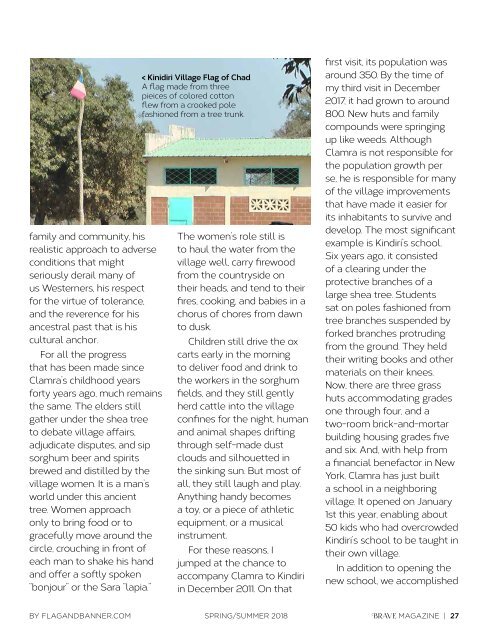Create successful ePaper yourself
Turn your PDF publications into a flip-book with our unique Google optimized e-Paper software.
family and community, his<br />
realistic approach to adverse<br />
conditions that might<br />
seriously derail many of<br />
us Westerners, his respect<br />
for the virtue of tolerance,<br />
and the reverence for his<br />
ancestral past that is his<br />
cultural anchor.<br />
For all the progress<br />
that has been made since<br />
Clamra’s childhood years<br />
forty years ago, much remains<br />
the same. The elders still<br />
gather under the shea tree<br />
to debate village affairs,<br />
adjudicate disputes, and sip<br />
sorghum beer and spirits<br />
brewed and distilled by the<br />
village women. It is a man’s<br />
world under this ancient<br />
tree. Women approach<br />
only to bring food or to<br />
gracefully move around the<br />
circle, crouching in front of<br />
each man to shake his hand<br />
and offer a softly spoken<br />
“bonjour” or the Sara “lapia.”<br />
> Kinidiri Village Flag of Chad<br />
A flag made from three<br />
pieices of colored cotton<br />
flew from a crooked pole<br />
fashioned from a tree trunk.<br />
The women’s role still is<br />
to haul the water from the<br />
village well, carry firewood<br />
from the countryside on<br />
their heads, and tend to their<br />
fires, cooking, and babies in a<br />
chorus of chores from dawn<br />
to dusk.<br />
Children still drive the ox<br />
carts early in the morning<br />
to deliver food and drink to<br />
the workers in the sorghum<br />
fields, and they still gently<br />
herd cattle into the village<br />
confines for the night, human<br />
and animal shapes drifting<br />
through self-made dust<br />
clouds and silhouetted in<br />
the sinking sun. But most of<br />
all, they still laugh and play.<br />
Anything handy becomes<br />
a toy, or a piece of athletic<br />
equipment, or a musical<br />
instrument.<br />
For these reasons, I<br />
jumped at the chance to<br />
accompany Clamra to Kindiri<br />
in December 2011. On that<br />
first visit, its population was<br />
around 350. By the time of<br />
my third visit in December<br />
2017, it had grown to around<br />
800. New huts and family<br />
compounds were springing<br />
up like weeds. Although<br />
Clamra is not responsible for<br />
the population growth per<br />
se, he is responsible for many<br />
of the village improvements<br />
that have made it easier for<br />
its inhabitants to survive and<br />
develop. The most significant<br />
example is Kindiri’s school.<br />
Six years ago, it consisted<br />
of a clearing under the<br />
protective branches of a<br />
large shea tree. Students<br />
sat on poles fashioned from<br />
tree branches suspended by<br />
forked branches protruding<br />
from the ground. They held<br />
their writing books and other<br />
materials on their knees.<br />
Now, there are three grass<br />
huts accommodating grades<br />
one through four, and a<br />
two-room brick-and-mortar<br />
building housing grades five<br />
and six. And, with help from<br />
a financial benefactor in New<br />
York, Clamra has just built<br />
a school in a neighboring<br />
village. It opened on January<br />
1st this year, enabling about<br />
50 kids who had overcrowded<br />
Kindiri’s school to be taught in<br />
their own village.<br />
In addition to opening the<br />
new school, we accomplished<br />
BY FLAGANDBANNER.COM<br />
SPRING/SUMMER 2018<br />
BRAVE MAGAZINE | 27


